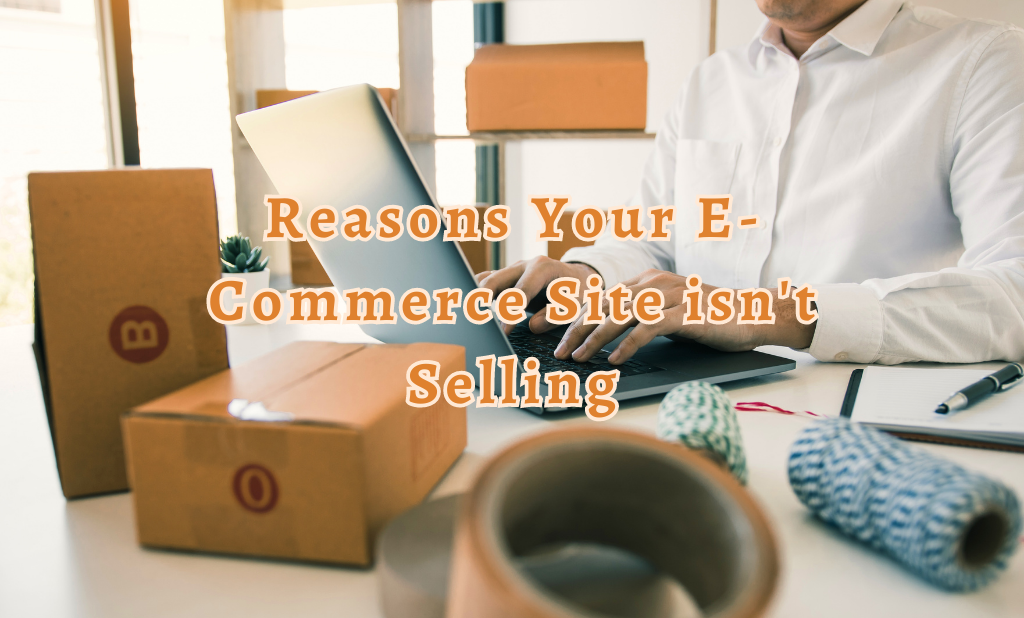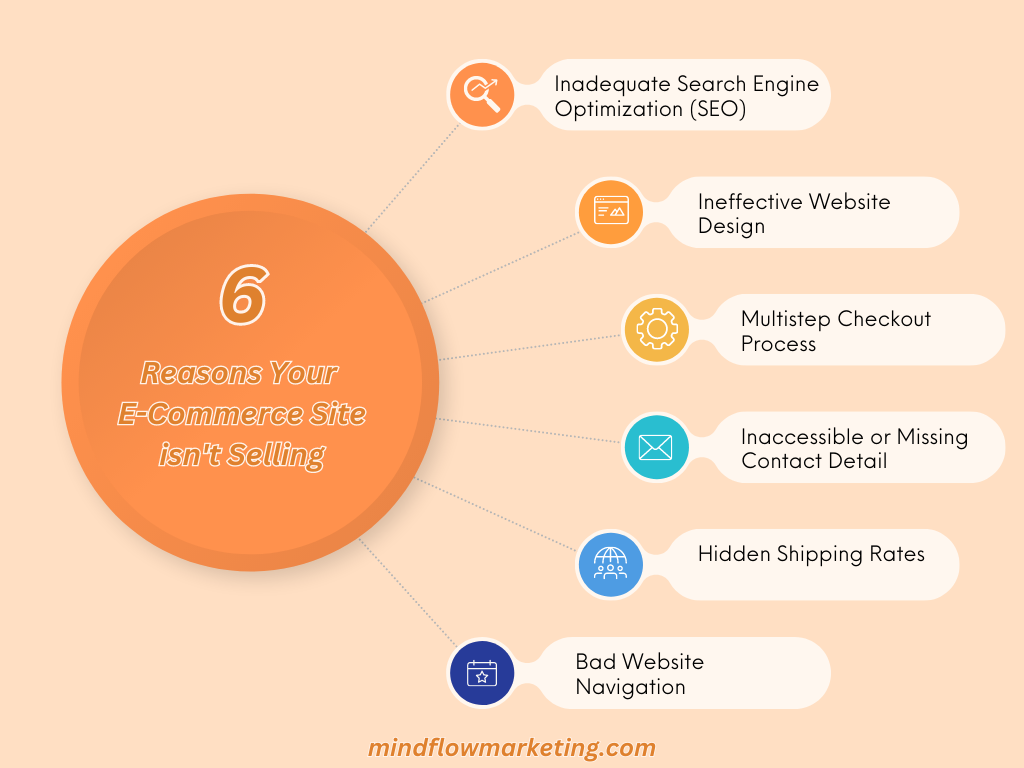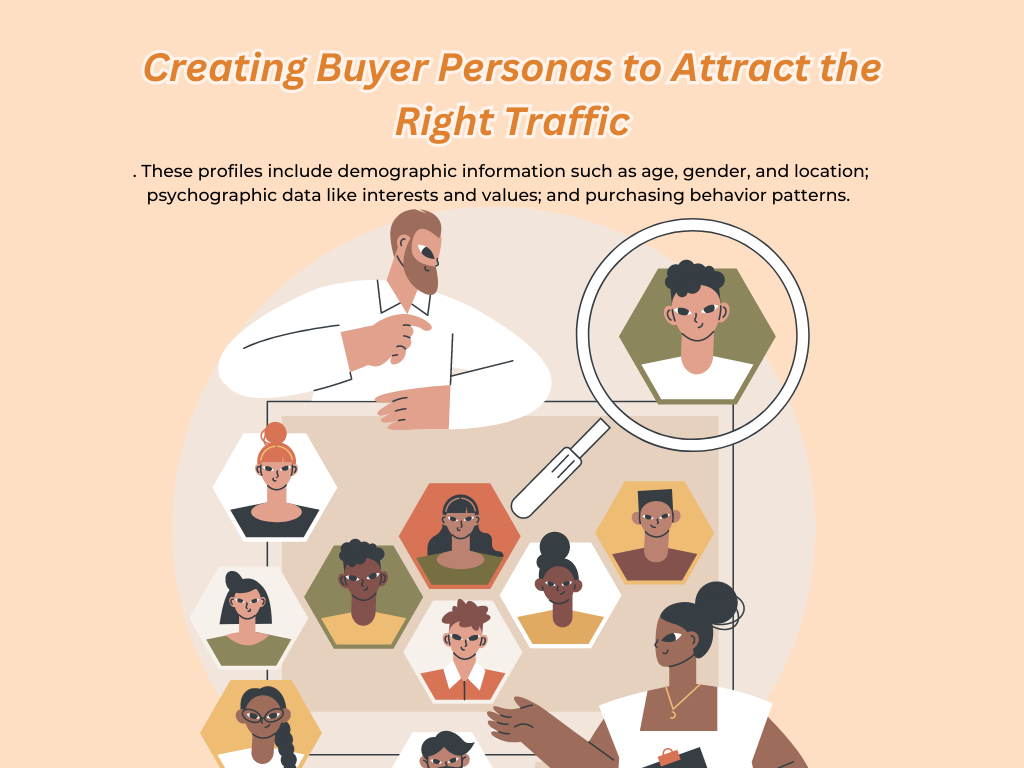You’ve come to the right place if you’re wondering why your eCommerce site isn’t selling. In this blog post, we’ll dive deep into six major reasons that might be hindering your online store’s success and provide actionable insights to overcome these challenges.
First, consider how inadequate SEO can impede your visibility in search engine results. By focusing on long-tail keywords, creating buyer personas, and conducting competitive market research, you can significantly improve your chances of attracting potential customers.
Secondly, we will discuss the role of ineffective website design in driving prospective buyers away. We’ll share tips on mobile compatibility for seamless shopping experiences across devices, integrating call-to-action buttons for clear guidance during purchases, and optimizing product pages with high-quality images and compelling descriptions.
In addition to these primary factors contributing to why your eCommerce site isn’t selling effectively, we will also touch upon simplifying the checkout process & implementing customer support tools like live video chat services such as ServiceBell. Stay tuned as we unravel the secrets behind successful eCommerce stores!

More Resources :
6 Reasons Your E-Commerce Site isn’t Selling

Reason 1: Inadequate Search Engine Optimization (SEO)
One of the primary reasons your eCommerce site may not sell is insufficient SEO efforts. It would be best if you pursued a targeted SEO campaign with long-tail keywords relevant to your niche market to increase visibility and attract potential customers. Creating buyer personas and conducting competitive market research can help you understand customer needs and differentiate yourself from competitors.
Focusing on Long-Tail Keywords for Improved Search Engine Rankings
Long-tail keywords are specific search phrases with lower search volume but higher conversion rates. Targeting these terms in your content strategy will improve your chances of ranking high on search engines. This approach will also drive more qualified traffic to your eCommerce site, increasing the likelihood of sales. Use tools like Ahrefs Keyword Explorer or Ubersuggest to find long-tail keyword opportunities within your niche.
Incorporating long-tail keywords into a targeted SEO campaign, creating buyer personas, and conducting competitive market research will improve visibility for potential customers searching online stores selling similar items within their desired price range, thus increasing overall sales performance significantly over time.
Creating Buyer Personas to Attract the Right Traffic
To better target potential customers through SEO efforts, it’s essential to create detailed buyer personas representing different segments of your audience. These profiles include demographic information such as age, gender, and location; psychographic data like interests and values; and purchasing behavior patterns. By understanding who you’re selling products to, online store owners can tailor their marketing strategies accordingly, increasing conversions and overall success levels across all channels, including organic searches via Google, Bing, Yahoo, etcetera.
Conducting Competitive Market Research for Better Pricing or Unique Features
Reason 2: Ineffective Website Design
Another factor contributing to poor sales performance is an ineffective website design that fails to engage potential customers or guide them through a seamless purchasing process. Ensuring mobile compatibility, integrating call-to-action buttons throughout the site, optimizing product pages with high-quality images, and persuasive copywriting skills are crucial in improving user experience while reducing abandoned carts caused by confusing navigation systems within sites.
Mobile Compatibility for Enhanced Shopping Experiences Across Devices
With the widespread use of mobile devices, it is imperative to have a site that can adapt accordingly for an optimal user experience. With most customers using their smartphones for online shopping, providing a responsive design can help enhance user experience and boost sales. Ensure your website automatically adjusts its layout based on the device being used so that customers can easily navigate your online store without hiccups.
Integrating Call-to-Action Buttons for Clear Guidance During Purchases
To effectively guide users through the buying process:
Optimizing Product Pages with High-Quality Images and Compelling Descriptions
Optimizing website design is essential for successful eCommerce sites, so steps should be taken to ensure this.
Incorporating these website design elements into your eCommerce site will improve user experience and contribute significantly towards boosting sales performance by guiding users through an engaging and seamless purchasing process.
Reason 3: Multistep Checkout Process
One of the most critical aspects that can significantly impact your eCommerce site’s sales is the checkout process. A complicated or confusing checkout experience may lead to customers abandoning their carts and leaving your online store without making a purchase. To drive sales, it is essential to simplify this process by identifying friction points and implementing solutions.
Identifying Friction Points in the Checkout Process
Analyzing your checkout process will help you pinpoint areas causing difficulties for customers during their shopping journey. Common issues include lengthy forms, unclear shipping costs, limited payment options, and forced account creation. Addressing these concerns and streamlining the entire purchasing experience can increase conversions on your eCommerce site.
Utilizing Live Video Chat Support Tools like ServiceBell
Besides simplifying the checkout process, providing proactive assistance through customer support tools can enhance user experiences on your eCommerce site. One such tool is ServiceBell, a live video chat platform that enables real-time interaction between shoppers and supports representatives when needed most – right within your online store. This personalized approach allows you to promptly address customer queries and concerns, leading to increased satisfaction and higher conversion rates.
Reason 4: Inaccessible or Missing Contact Detail
Regarding e-commerce, having accessible and visible contact details is essential for customer satisfaction. Without them, customers may feel like they are being left in the dark with no one to turn to if something goes wrong. This can lead to a decrease in sales and trust from potential buyers.
If your contact information is missing or difficult to find, it could cost you sales. Customers want reassurance that their purchase will be handled should anything go wrong, so not providing easy access to your contact information can make them hesitant about buying from you.
When customers don’t have an easy way of contacting you, they won’t trust that their concerns will be addressed promptly and professionally. They might think twice before purchasing if there isn’t someone available who can help them when needed – even if the product looks great!
Even if customers find your contact details after some digging around on your website, this extra effort may put them off altogether – especially those who are short on time or just browsing casually for products online. All the necessary information must be readily available so shoppers can quickly and easily find what they need.
Reason 5: Hidden Shipping Rates
Hidden shipping rates can be a major deterrent to online sales. Customers don’t like surprises, and when they find out that the purchase cost is higher than expected due to hidden shipping fees, they’ll likely abandon their cart and look elsewhere for what they need.
Be Upfront About Any Additional Costs
E-commerce stores must ensure customers know exactly how much their purchase will cost before checkout. This means being upfront about any additional costs associated with shipping, such as handling fees or taxes.
Offer a Shipping Calculator on Your Website
A good way to do this is by offering a shipping calculator on your website so customers can get an accurate estimate of the total cost of their order before committing to buy anything.
Display All Available Delivery Options at the Beginning
Another issue related to hidden shipping rates is that some stores offer free or discounted delivery options but only advertise them after customers have gone through the entire checkout process. This practice could make shoppers feel tricked into paying more than necessary for something they could have gotten cheaper if they had known about it sooner.
To avoid this problem, clearly display all available delivery options at the beginning of the checkout process so shoppers are aware of them from the start and can decide which one works best for them financially.
Ensure All Applicable Information Regarding Price Changes is Displayed Prominently
Finally, another common cause of hidden shipping charges is when retailers set different prices based on where a customer lives or what product they’re buying – without making these differences clear up front in either scenario. If you use variable pricing models like this in your store, ensure that all applicable information regarding price changes is displayed prominently throughout your site so customers won’t be caught off guard later on during checkout when unexpected charges appear on their bill.
Reason 6: Bad Website Navigation
Bad website navigation can be the bane of any e-commerce site. It’s like finding a needle in a haystack; it takes forever, and you’re always wondering if you’ve found what you were looking for. Ensure all pages are easy enough for anyone from tech novices to experts to understand without having them guess their way around your site accidentally or intentionally! Learn everything you need to know about creating a good web design from here.
Ensure All Buttons & Links are Properly Sized
Poorly designed websites with cluttered layouts, small buttons, and tiny product images make navigating an online store difficult at best. This is especially true when using mobile devices with much smaller screen sizes than desktop computers. To ensure customers have a positive experience on your website, ensure all buttons and links are properly sized so they can easily be clicked or tapped on a mobile device.
Design a Responsive Web Store
Additionally, design your web store to be responsive so that it automatically adjusts its layout depending on the size of the user’s device screen. This will help eliminate frustration caused by having to scroll around or zoom in to find what they need quickly and efficiently.
Provide Clear Labels
Another important factor is providing clear labels for each page within your website’s navigation menu bar and submenus when necessary. You want users to know exactly where they’re going before clicking through because nothing frustrates people more than being taken somewhere unexpected after clicking on something that was supposed to lead them elsewhere!
Frequently Asked Questions Concerning Reasons Your E-commerce Site Isn’t Selling.
Conclusion
You can reach its peak performance by tackling the two primary motives behind a lack of sales on your e-commerce site. Improving SEO strategies, website design, and simplifying checkout processes and customer support tools are all essential steps in increasing sales in an online store. As a result of taking these measures, businesses should experience increased revenue from their e-commerce sites over time. With this knowledge of 6 reasons your e-commerce site isn’t selling at hand, it’s now up to you to take action.
